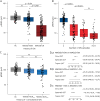Retinal Optical Coherence Tomography in Neuromyelitis Optica
- PMID: 34526385
- PMCID: PMC8448522
- DOI: 10.1212/NXI.0000000000001068
Retinal Optical Coherence Tomography in Neuromyelitis Optica
Erratum in
-
Retinal Optical Coherence Tomography in Neuromyelitis Optica.Neurol Neuroimmunol Neuroinflamm. 2021 Dec 22;9(2):e1132. doi: 10.1212/NXI.0000000000001132. Print 2022 Mar. Neurol Neuroimmunol Neuroinflamm. 2021. PMID: 34937739 Free PMC article. No abstract available.
Abstract
Background and objectives: To determine optic nerve and retinal damage in aquaporin-4 antibody (AQP4-IgG)-seropositive neuromyelitis optica spectrum disorders (NMOSD) in a large international cohort after previous studies have been limited by small and heterogeneous cohorts.
Methods: The cross-sectional Collaborative Retrospective Study on retinal optical coherence tomography (OCT) in neuromyelitis optica collected retrospective data from 22 centers. Of 653 screened participants, we included 283 AQP4-IgG-seropositive patients with NMOSD and 72 healthy controls (HCs). Participants underwent OCT with central reading including quality control and intraretinal segmentation. The primary outcome was thickness of combined ganglion cell and inner plexiform (GCIP) layer; secondary outcomes were thickness of peripapillary retinal nerve fiber layer (pRNFL) and visual acuity (VA).
Results: Eyes with ON (NMOSD-ON, N = 260) or without ON (NMOSD-NON, N = 241) were assessed compared with HCs (N = 136). In NMOSD-ON, GCIP layer (57.4 ± 12.2 μm) was reduced compared with HC (GCIP layer: 81.4 ± 5.7 μm, p < 0.001). GCIP layer loss (-22.7 μm) after the first ON was higher than after the next (-3.5 μm) and subsequent episodes. pRNFL observations were similar. NMOSD-NON exhibited reduced GCIP layer but not pRNFL compared with HC. VA was greatly reduced in NMOSD-ON compared with HC eyes, but did not differ between NMOSD-NON and HC.
Discussion: Our results emphasize that attack prevention is key to avoid severe neuroaxonal damage and vision loss caused by ON in NMOSD. Therapies ameliorating attack-related damage, especially during a first attack, are an unmet clinical need. Mild signs of neuroaxonal changes without apparent vision loss in ON-unaffected eyes might be solely due to contralateral ON attacks and do not suggest clinically relevant progression but need further investigation.
Copyright © 2021 The Author(s). Published by Wolters Kluwer Health, Inc. on behalf of the American Academy of Neurology.
Figures


References
-
- Bouyon M, Collongues N, Zéphir H, et al. . Longitudinal follow-up of vision in a neuromyelitis optica cohort. Mult Scler. 2013;19(10):1320-1322. - PubMed
Publication types
MeSH terms
Substances
LinkOut - more resources
Full Text Sources
Medical
Miscellaneous
